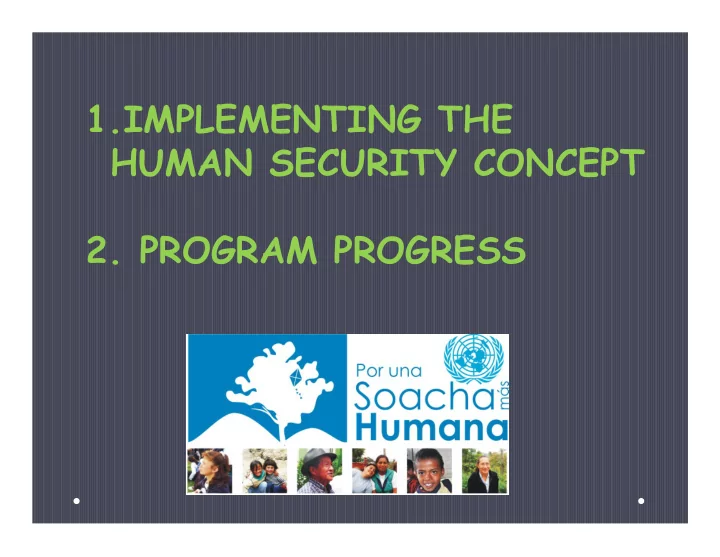

1.IMPLEMENTING THE HUMAN SECURITY CONCEPT 2. PROGRAM PROGRESS
1. IMPLEMENTING THE HUMAN SECURITY CONCEPT According to the human security principles
PROTECTION OBJECTIVE “TOP-DOWN” Support the formulation of public policies (gender, youth, IDP, food security and health) Contribute to the improvement of human security conditions of the most vulnerable groups in Soacha and to the improvement of local response mechanisms EMPOWERMENT OBJECTIVE “BOTTOM-UP” Community empowerment and acces to basic social services
PEOPLE CENTERED Participatory formulation and implementation process. • UN Interagency Group carried out monthly context • analysis focusing on individuals. Identification of people-centered strategies in order to • address ongoing human security threats that affect their livelihood and dignity. Promotion of new community leaders. •
MULTI-SECTORAL COMMUNITY NGOs COORDINATION GOVERNMENTS UNITED NATIONS
COMPREHENSIVE The Program addresses the wide spectrum of threats • affecting Soacha´s habitants. In the field, some strategies promoted the integration of • different human security dimensions.
ECONOMIC SECURITY COMMUNITY SECURITY HEALTH AND FOOD SECURITY
POLITICAL SECURITY PERSONAL COMMUNITY SECURITY SECURITY
CONTEXT SPECIFIC Activities and methodologies have been adapted to the local context, according to the monthly context analysis carried out by UN Agencies. This allowed the development of strategies taking into account local realities and dynamics.
PREVENTION-ORIENTED One of the main focus of the Program is the formulation of public policies that ensure a medium and long term institutionalization of actions planned to protect and empower the community. Through the work done at the roundtables and committees, capacities have been strengthened to face the most immediate problems of vulnerable groups.
2. PROGRAM PROGRESS
PROTECTION OBJECTIVE 76% EMPOWERMENT OBJECTIVE 87% 120 120 100 100 80 80 60 60 40 40 20 20 0 0 Children IDP Healthy Food and children housing security youth
PARTICIPANTS • From June 2010 until April 2012 the Joint Program has 6,778 direct beneficiaries • 63% women (18% IDP) and 37% men (10% IDP) Participants in different Participation of UN strategies women and men 2% MEN IDP 6% 11% 10% 1-2 estrategias WOMEN 3 estrategias MEN NO NO IDP 4 estrategias IDP 45% 27% 5 estrategias WOMEN 81% IDP 18%
% OF RESOURCES EXPENDED BY AGENCY UNTIL MAY 2012 100% 100% 100% 94% 92% 85% 74% 71% 48%
Recommend
More recommend